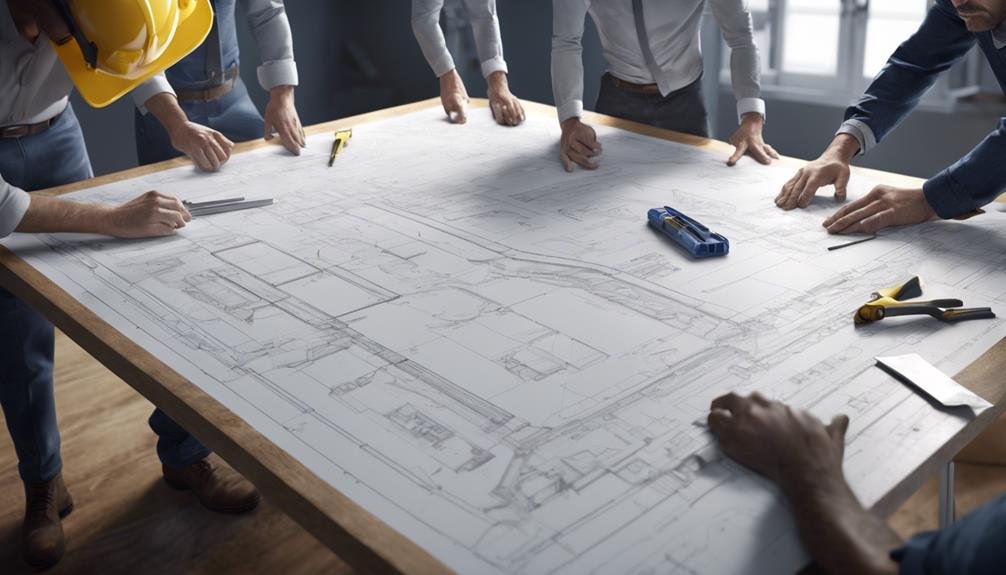The Art of Negotiation: Techniques for Construction Professionals
Mastering negotiation is key for construction pros. Strategize for favorable outcomes in contracts and disputes. Enhance conflict resolution skills to prevent delays. Focus on effective communication and problem-solving. Adapt to different styles and build trust for success. Set clear objectives and know limits to guide negotiations. Understand power dynamics for leverage. Aim for win-win solutions through collaboration and mutual benefit. Improve by honing listening skills and seeking beneficial outcomes. Mastering these techniques can elevate your success in the construction industry.
Key Takeaways
- Master active listening and clear communication skills.
- Understand power dynamics and leverage them effectively.
- Focus on collaborative problem-solving for win-win outcomes.
- Establish trust, rapport, and clear objectives in negotiations.
- Practice adaptability in communication styles for diverse personalities.
Importance of Negotiation Skills
Understanding the pivotal role negotiation skills play in the success of construction professionals is essential for maneuvering through the complexities of the industry effectively. Negotiation strategies are important tools for achieving favorable outcomes in various scenarios within the construction sector. By honing your negotiation skills, you can navigate contract discussions, project changes, and disputes with finesse.
Conflict resolution is another significant aspect closely tied to negotiation skills. Being adept at managing conflicts can prevent delays, cost overruns, and damaged relationships. Effective conflict resolution involves actively listening to all parties, identifying underlying issues, and finding mutually beneficial solutions. By mastering conflict resolution techniques, you can mitigate tensions and foster a collaborative environment on construction projects.
Understanding Different Communication Styles
To effectively navigate through different communication styles in the construction industry, it's important to recognize and adapt to the diverse ways individuals convey information and interact with one another. Understanding different personalities is vital in fostering effective communication within construction projects. Some team members may prefer direct and concise communication, while others may appreciate more detailed explanations. By being aware of these preferences, you can tailor your communication style to make sure that information is conveyed clearly and efficiently to all parties involved.
Effective communication involves not only what's said but also how it's said. Some individuals may respond better to a collaborative and inclusive communication approach, while others may prefer a more authoritative tone. By recognizing these variations in communication styles, you can build stronger relationships with team members and stakeholders, ultimately enhancing project outcomes. In construction negotiations, adapting your communication style to suit different personalities can help create a more cohesive and productive working environment.
Building Trust and Rapport
Establishing trust and building rapport are foundational elements in the construction industry that greatly impact project success and team dynamics. Building relationships with clients, stakeholders, and team members is essential for fostering collaboration and achieving mutually beneficial outcomes. To build trust, it's vital to demonstrate integrity, competence, and reliability in all interactions. By consistently delivering on promises and being transparent in your communication, you can establish credibility and earn the trust of others.
Creating a positive rapport involves actively listening to others, showing empathy, and seeking to understand their perspectives. Taking the time to build personal connections and showing genuine interest in the people you work with can go a long way in strengthening relationships and fostering a productive working environment. By investing in trust and rapport, you lay a solid foundation for effective communication, problem-solving, and successful negotiations in the construction industry. Remember, building trust takes time and effort, but the long-term benefits are invaluable.
Setting Clear Objectives and Limits
When approaching negotiations, make sure you establish clear objectives and limits to guide your discussions effectively.
Goal clarity is essential in keeping your team focused and aligned throughout the negotiation process.
Goal Clarity
Achieving goal clarity is crucial for construction professionals to effectively set clear objectives and limits in their negotiations.
To guarantee success, start by defining your clear objectives with a strategic approach. Align your goals with the desired outcome and establish a plan to achieve them.
Utilize assertive communication to express your objectives confidently and clearly. By being specific about what you aim to achieve and the limits you're willing to accept, you create a focused negotiation strategy.
This clarity helps guide the conversation towards mutually beneficial agreements. Remember, goal clarity not only aids in achieving your desired outcomes but also sets the foundation for a productive and structured negotiation process.
Boundary Establishment
In order to guarantee successful negotiation outcomes, construction professionals must meticulously define their objectives and limits when engaging in boundary establishment discussions. When establishing boundaries, effective communication is key.
Here are four essential steps to help you set clear objectives and limits:
- Define Your Goals: Clearly outline what you aim to achieve through the negotiation process.
- Identify Non-Negotiables: Determine what aspects are essential and can't be compromised.
- Communicate Clearly: Articulate your boundaries effectively to ensure mutual understanding.
- Be Firm but Flexible: While maintaining your limits, remain open to alternative solutions that benefit all parties involved.
Overcoming Common Negotiation Challenges
To navigate the common negotiation challenges faced in construction, professionals must develop a proactive approach that emphasizes effective communication and problem-solving skills. Conflict resolution and problem-solving are vital when disputes arise during negotiations.
Employing active listening and empathy can help in understanding the other party's perspective, paving the way for compromises that benefit all involved. Effective communication is key to overcoming misunderstandings and ensuring that both parties are on the same page throughout the negotiation process. Clear and concise communication can help in clarifying expectations and avoiding potential conflicts.
Additionally, the ability to compromise is essential in reaching mutually beneficial agreements. Professionals should be prepared to offer concessions while also standing firm on essential points. By focusing on problem-solving, actively listening, and maintaining open communication channels, construction professionals can navigate negotiation challenges successfully, fostering positive relationships and achieving favorable outcomes.
Leveraging Power Dynamics Effectively
When maneuvering negotiation dynamics in construction, understanding and effectively leveraging power dynamics can greatly influence the outcome of discussions. Power dynamics refer to the relationships and influence tactics used by parties involved in negotiations. To leverage power dynamics effectively, consider the following strategies and assertiveness techniques:
- Identify Power Imbalances: Recognize where power lies within the negotiation process. Understanding who holds the most influence can help you tailor your approach accordingly.
- Build Strategic Alliances: Forming alliances with key stakeholders can enhance your negotiation position and provide additional leverage during discussions.
- Use Information Wisely: Utilize information asymmetry to your advantage by strategically sharing or withholding information to influence the negotiation process.
- Maintain Confidence and Assertiveness: Assert your needs and interests clearly while maintaining a respectful and professional demeanor. Confidence can help you navigate power dynamics effectively and achieve your negotiation goals.
Negotiating Win-Win Solutions
Understanding the mutual benefits and collaborative approaches in negotiation is key to achieving win-win solutions in construction projects. Collaborative problem-solving and effective communication are fundamental in creating mutually beneficial agreements that foster positive relationships and project success. By working together with stakeholders, you can uncover shared interests and goals, paving the way for creative solutions that address everyone's needs.
To illustrate this further, consider the following table showcasing key elements of negotiating win-win solutions:
| Key Elements | Description | Importance |
|---|---|---|
| Collaborative Problem-Solving | Involves all parties working together to find solutions that meet everyone's needs. | Encourages open dialogue and cooperation. |
| Effective Communication | Clear and transparent communication guarantees that all parties understand each other's perspectives. | Prevents misunderstandings and promotes trust. |
| Mutual Benefit | Focuses on creating outcomes that benefit all parties involved in the negotiation. | Builds strong partnerships and fosters future collaboration. |
Practicing and Improving Negotiation Techniques
To enhance your negotiation skills, focus on honing your active listening abilities. Aim for win-win solutions and pay attention to nonverbal communication cues.
By actively engaging in conversations, seeking mutually beneficial outcomes, and being attuned to both verbal and nonverbal signals, you can notably improve your negotiation techniques.
Incorporating these elements into your practice will help you navigate construction negotiations more effectively and efficiently.
Active Listening Skills
Enhance your negotiation skills by honing your ability to actively listen during discussions in the construction industry. Active listening is essential for effective communication and successful negotiations. Here's how you can improve your active listening skills:
- Give your full attention: Focus on the speaker without distractions.
- Show that you're listening: Nodding and making eye contact.
- Paraphrase and clarify: Repeat key points to show understanding.
- Ask open-ended questions: Encourage the speaker to elaborate on their thoughts.
Win-Win Solutions
Developing win-win solutions is an essential aspect of honing negotiation techniques for construction professionals. By focusing on mutual benefits and adopting a collaborative approach, you can create outcomes that satisfy all parties involved.
When aiming for win-win solutions, it's vital to prioritize problem-solving and mutual gain. This involves understanding the interests and concerns of both sides, seeking common ground, and brainstorming creative solutions that address everyone's needs.
Emphasizing open communication and a willingness to explore different perspectives can facilitate the process of reaching mutually beneficial agreements. By fostering an environment of cooperation and respect, construction professionals can enhance their negotiation skills and cultivate successful long-term relationships within the industry.
Nonverbal Communication Cues
When practicing and improving negotiation techniques, construction professionals should pay close attention to nonverbal communication cues to enhance their understanding of the underlying dynamics in a negotiation setting. Nonverbal cues can often reveal more than words alone, providing valuable insights into the other party's thoughts and intentions.
Key nonverbal communication cues include:
- Body Language: Observe the other party's posture and movements to gauge their level of comfort or agitation.
- Eye Contact: Monitor the frequency and duration of eye contact to assess sincerity and interest.
- Gestures: Pay attention to hand movements and gestures, as they can convey emotions and emphasis.
- Facial Expressions: Read facial cues for signs of agreement, disagreement, or hidden feelings.
Conclusion
To sum up, mastering the art of negotiation is essential for construction professionals to successfully navigate complex projects and relationships. By understanding communication styles, building trust, setting clear objectives, and overcoming challenges, you can achieve win-win solutions and create mutually beneficial outcomes.
For example, imagine negotiating a contract with a difficult client and using your newfound negotiation skills to find common ground and reach a mutually satisfactory agreement. Keep honing your negotiation techniques to excel in the construction industry.







